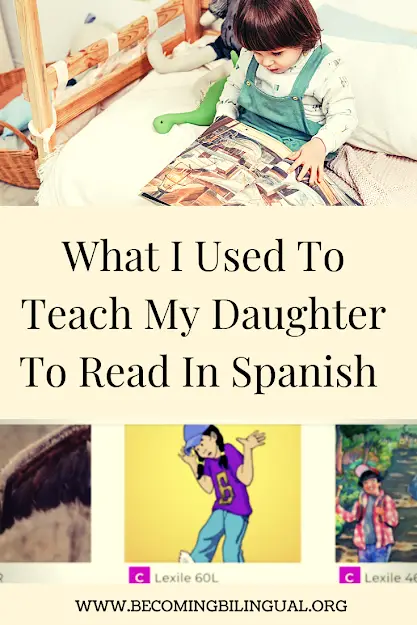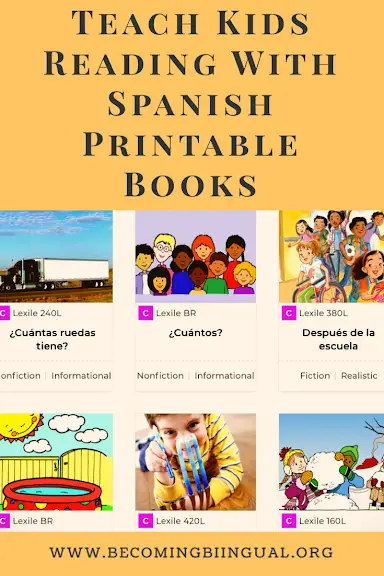What I Used To Teach My Daughter To Read In Spanish

When my daughter was three years old she told me that she wanted to learn how to read. She attended a Montessori preschool where the age range was 3-6 years old and she saw that older peers were starting to read books.
I wondered if I should teach her to read in Spanish or English. At home, we only speak Spanish and I spend a lot of time looking for Spanish resources to help boost her Spanish language skills as well as my own.
I decided that I’d teach her to read in Spanish and that she’d learn to read in English at school when her teachers determined that she was ready.
Table of Contents
Before She Read In Spanish
Before learning to read, there are a lot of pre-literacy activities that children should be exposed to including singing nursery rhymes, hearing poems and rhymes, playing with the sounds of the language and doing letter recognition activities. My daughter knew her letters and letter sounds in Spanish before she entered preschool and had a strong foundation in nursery rhymes and Spanish language, so she had a literacy foundation to work from.
For more information on teaching your child to read check out this post here with links to some important websites for Spanish reading:
How To Use These Epic Online Spanish Books For Beginners

Up until this point, I had been slowly building our Spanish language library, but I’d mostly focused my Spanish book search on getting picture books and chapter books, I didn’t have any books on hand that were accessible for helping her learn to read.
For beginning reading, I was looking for books that were mostly labeling- a book with a picture of a chair and a 2-3 word phrase that matched like, “The chair”.
With books like these I could help my daughter understand the association between words and pictures in the story and point to the words that she was reading to understand that each word in print is equal to one word spoken (1:1 correspondence).
I was thinking of something like the BOB books in English, but I had nothing like this in my home and was unsure of where to get anything like this in Spanish.
What Is Reading A-Z?
Reading A-Z is a source that was first in English and has since released their books in many languages including large collections and resources in Spanish and French as well as book translations in Polish, Ukrainian and Vietnamese.
I think that the site is geared towards educators and schools, but there are family resources as well and plenty of information on using the resources to support reading at all levels.
Their site requires a paid membership for schools and families but comes with a 14 day trial that I highly recommend since you can download and print books during the trial and see all of their resource pages.

Here’s What We Like About Reading A-Z
Leveled Books
When you navigate the Reading A-Z site there is a subheading called, “Spanish Leveled Books”. This is the area that I access the most and find the most valuable on their site. There are over 1,000 books in Spanish on their site that are at various reading levels. At the top of the page there is a way to filter the books by fiction, nonfiction, with support materials, etc. The books are leveled using a Reading A-Z letter leveling system where ‘aa’ is the most basic and for beginning readers and ‘Z’ is the most advanced for up to 5th grade.
When I started looking for books with my daughter I started with ‘aa’ books. I picked books that I thought would go with different parts of our day or themes that she was familiar with and I printed them using the single page book printing instructions. The little printed books are usually 10 pages long and have a simple phrase on each page that directly match the picture that is presented.
As your child progresses and is ready for increasingly harder books, you can choose different levels of material to match them. You can also use the ‘projectable’ view for each book and read it from your phone or device instead of printing it out.
Follow Up Activities
Many of the Spanish leveled books come with follow up activities that teach a Spanish reading skill. Once you click on a book that you’d like to use, you’ll see a section called, “Lesson Resources”. This section usually has worksheets with ideas for follow up activities that you can do with the book that you selected. They might include cut and paste activities, drawing, sentence work, and other various exercises.
The follow up activities are especially great as your child gets into higher levels and would benefit from some direct Spanish grammar work to help them with their reading and comprehension.
Authentic Spanish Books
A lot of the Spanish leveled books on the Reading A-Z site are translations of their English texts; however, they do have a section “Authentic Spanish Books”. This section includes books that have been written originally in Spanish as well as several book series that have Hispanic themes; such as biographies of famous Latin Americans or Spanish language myths and legends.
The authentic books are important to check out because they are created with Spanish language readers in mind and tend to have themes that are more relevant to Spanish language culture.
There is another section on their Spanish language area called, ‘Songs and Rhymes’ which is a collection of traditional Spanish poems and nursery rhymes in book or poster form. All of the works were written originally in Spanish and include authentic and traditional songs and poems from Latin America. This section is great for working on rhyming, language rhythm and Spanish vocabulary building.
Foundational Resources
Another section that has a lot of good information is the ‘foundational resources’ area. This includes several resources for beginning readers like letter flashcards, letter formation and handwriting practice and common sight words cards. Once your child is really starting to get into Spanish reading, these resources can help push them to higher levels as they get more targeting letter and word practice.
For more information or to check it out for yourself, follow this link to their website:
For more information on a site with audiobooks as well as online books for reading practice, check out this post here:
How To Improve Your Language Skills With This Interesting Experiment!
Learning to read in Spanish is one way that you can help to develop your child’s bilingual ability. Starting young and using proven resources is one way that you can help to set them up for success.
Stay tuned for more resources for becoming bilingual!
Happy Learning!
Subscribe here to get my latest posts and resources delivered directly to your inbox!
2 thoughts on “What I Used To Teach My Daughter To Read In Spanish”